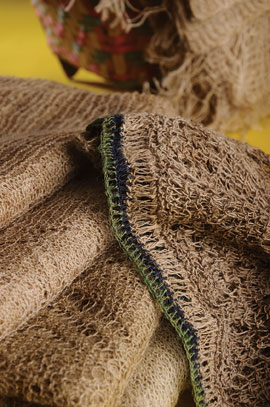“With a tiny bit of effort, the nettle would be useful,” wrote Victor Hugo once. The Rai community must have had a similar notion because the allo, a fiber drawn out of the nettle plant, is much sought after due to its multipurpose nature
Back in the old days, native Rai communities living in the hilly areas of Nepal discovered that they could weave cloths out of wild shrubs that grew like weeds in the surrounding forests. Soon, this discovery led to a craft that so infiltrated their lifestyle, it became indispensable, both in their daily life as well as in their cultural and religious practices. For the past few decades, this very same fabric, locally known as ‘allo,’ has been getting a facelift, enabling it to reach past its local production area to the world beyond Nepal.

Allo is a natural fiber extracted from a perennial shrub known as the Himalayan giant nettle (Girardinia diversifolia) which grows in abundance at altitudes ranging from 1200m to 3000m. It is harvested every winter from November to February from community forests. The entire plant is cut a few inches above ground level so that a new one grows from the old roots, ready to be collected again next year. In order to extract the fiber, the inner bark is peeled out, dried and boiled with ash, then washed, spun and woven into the final product, the allo fabric.
The allo fabric, thanks to its versatility and durability, can be used to make absolutely anything - from scarves, shirts and rolls of cloth to bags, purses and even shoes. Lila Rai from Allo Cloth Production Club swears by it. “The material doesn’t tear easily and wears out far slower than other fabrics,” she says. According to Rai, allo also has anti-allergic properties and is very soothing for hyper sensitive skin. In addition, nettles grow wild, even under harsh conditions, and do not require fertilizers or pesticides. Unlike other plants, they regenerate from the leftover shoots year after year making them sustainable and very environment friendly.
Generally, the workers involved in the production of allo fabric are local housewives from indigenous Rai, Gurung and Magar communities. Rai states that the initial objective of allo cloth production was to utilize the local resources, natural and human, to promote local culture and improve the living standards of these communities, which it has been quite successful in doing.
Like many genuine Nepali products, allo gives back its value for money. This versatile, durable and eco-friendly fabric has already started making waves and appears to be here to stay.









